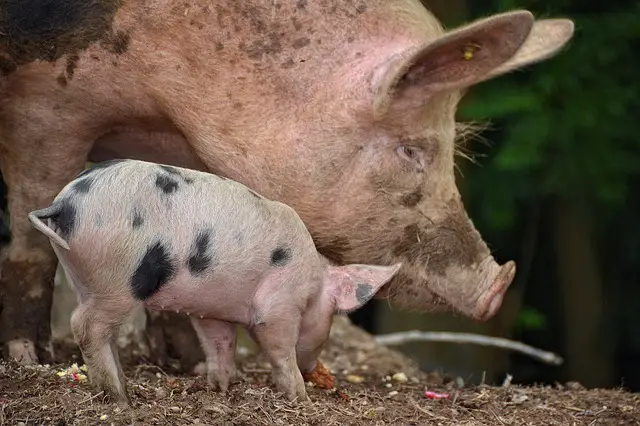Just like other mammals, pigs need to take care of their young in order to secure the race will go on. However, not all pigs are capable of being good mothers naturally and some can make accidents. We researched about how most mother pigs manage motherhood with their piglets.
How do pigs take care of their young? Sows (mother pigs) often call to their young using a special “song” to let them know it is time for feeding. She feeds them and teaches them proper pig behavior. They will become aggressive and territorial for the sake of protecting her young.
Most of the time, piglets will follow their mother around just like most baby mammals and that is how they learn from their mother how they will take care of themselves.
Some animals are born to be independent right off the bat, but pigs raise their piglets with love and care. They do get attached to other people and pigs, what more with their own babies?
Mother pigs will discipline bad behavior by pushing and nudging the piglets to let them know they are misbehaving. Biting may occur at times when a piglet is also being violent.
Sometimes, the only way to make naughty kids stop is to give them a taste of their own medicine and some mother pigs know this for a fact.
They are also known to maintain their maternal love and care even after the piglets have become fully grown.
Mothers will always stick by their babies’ side and will continue to be protective over them.
When the birth is still fresh, mothers often prepare large beds for her babies to rest and sleep on and prioritize their comfort more than her own.
Sometimes, using her own body, she will keep them warm if it is cold and teach them how to cool off by seeking water or mud.
She forages food for her young and lets them eat before she does.
During this process, her babies will also learn how to forage on their own by watching the mother pig how to do it.

Not all pigs can be flawless mothers and sometimes they might require our assistance to make their motherhood a lot easier. Read on to find out how we can guide mother pigs with her young.
When should we start preparing for the birth of young piglets
When you are raising a pig, it is important to prepare for their pregnancy and birthing process. Pigs are normally pregnant for 115 days or 3 months, 3 weeks and 3 days.
You will notice when a pig is about to give birth when they keep trying to make a “nest” where she may want to give birth to her babies and when her vulva will enlarge and her teats will swell more than before.
How many piglets can a sow give birth to
Most pigs commonly produce up to 12 piglets. However, depending on the way they are raised and their breed’s standards, the number of piglets may differ.
A breed called the Large Black pig holds the Guinness World Book of Records for the largest number of litters produced ever recorded for pigs — the sow giving birth to 26 litters (piglets) around the years 1940 and 1952.
Another breed called Meishan pigs is popular for their great number of liters. They can produce 15 to 22 litters (piglets) and have high pregnancy success rate. They have great mothering skills too.
If you’re interested in learning more about breeding, you can check our article about that here.
Keep in mind that it can be difficult to predict pigs due to their diverse genetics.
The same thing can be said for their appearance, behavior, weight and personalities. Everything can turn out differently for every pig.
When should we guide sows when taking care of her young
As mentioned earlier, there are times when a mother pig can make accidents and we all want to avoid that. Sometimes, we must intervene with nature and guide a sow with her piglets.
The most common accident with pig pregnancy and birthing is unknowingly crushing piglets and suffocating them with the mother’s body.
Some mother pigs may not be aware that they are already sitting on or lying on one of her offspring!
When this happens, owners are often forced to intrude and rescue the babies before they get killed unintentionally.
But be warned! Mothers can be scary or aggressive due to her protectiveness towards her babies.
Approach the den warily and make sure you do not scare off the mother. It will also be helpful if you have already established a bond with your pig so they can trust you around their babies.
Once you are close enough to grab hold of the piglet, carefully place them somewhere else but still keep them close their mother.
Why we need to clip the teeth of young pigs and dock their tails
Another reason why we must intrude is to make feeding piglets easier for the mother.
Piglets are born with needle sharp teeth that must be clipped a few moments or hours after birth! If not clipped, the mother will suffer bite injuries and will have a hard time feeding her piglets and may reach the point of refusing to feed them.
Teeth clipping can be done on your own but if you are inexperienced, you may read a guide about it here.
If necessary, it may also be important to dock a pig’s tail. Sometimes, you may see pigs without tails or with much shorter tails than usual.
This is because some owners are forced to dock tails because other piglets bite each other’s tails and leave wounds that could lead to infections.
How pigs defend their young against predators
Pigs rely on their speed most of the time to flee from predators. Wild or domesticated, a pig’s speed is their number one defense from any attacker.
However, mother pigs will have a hard time defending if her piglets are still too young to run at full speed. She can only rely on her sense of smell and hearing to get by.
So how do mother pigs defend from predators?
The sad reality is they often get sacrificed to predators or get away barely alive when faced with powerful predators.
Mothering pigs in the wild do their best to avoid danger as much as possible for her babies but if left without a choice, a prey animal like pigs will be forced to fight back in order to protect her babies.
All pigs regardless of breed and gender grow tusks, but female pigs rarely have tusks long and large enough to stick out of their mouth therefore they can only fight back through pure physical body strength.
She will charge at attackers and tackle them down with her body and make opportunities for her babies to escape and then she will follow. Mother pigs will fight attackers to death if necessary.
That is how fiercely loyal a mother pig can be.
Sometimes, not all mother pigs can be the same but it is the common behavior among pigs regardless if they are wild or domesticated.
Besides, pigs ranked as the fourth most intelligent animal in the world. They can think of several ways to outsmart attackers!
Piglets learn most from their mothers and an encounter with a predator can truly give them a lot of lessons just by remembering the way their mothers would react in such situation.
Why some pigs consume and attack their own young
Cannibalism is not common behavior among pigs. When pigs eat other pigs, the savage act usually occurs when mothers devour their liter (piglets).
As of today, there is no accurate explanation yet as to why some sows (mother pigs) eat their offspring but theories suggest that it could be due to starvation, irritation, mental problems or the sow could tell the offspring won’t live long because of a hidden illness that we may not know of.
There are cases when sows are provided with all their needs but still eat her babies. It is truly a mystery and a rare phenomenon thus we still do not have a clear answer so far.
This type of behavior should be monitored closely and pigs that exhibit acts of cannibalism can be considered dangerous as they may have mental illness that we do not know off and can become violent.
Cannibalism can also happen with boars (male pigs) when starvation strikes, there are not many options left for them. They may eat piglets or even kill other adult pigs.
This is a rare behavior but chances of it occurring among wild pigs are higher than domesticated pigs.
Pigs MAY eat the carcasses or decaying bodies of another dead pig or unconsciously eat pig meat when handed to them by humans.
But once again, it is not their natural behavior even if they are omnivores.
Related Questions
- What animals are predators of pigs?
Pigs can be found in many different
types of places because they are flexible creatures and thus they have
different kinds of predators too.
We listed some of the most common predators known to pigs below.
- Humans
- Coyotes
- Hyenas
- Cougars
- Grizzly Bears
- Wolves
- Dogs
- Raccoons
- Bobcats
- Lions
Aside from land moving enemies, pigs can have uncommon flying predators in the wild as well.
- Owls
- Eagles
These large raptors can easily snatch young piglets and harm even fully grown pigs with their sharp claws and leave open wounds by pecking with their beaks.
Other rare predator(s) are also included below.
- Snakes — usually do not hunt pigs as pigs can fight back and potentially kill them and be eaten instead. The breed “American Guinea Hog” is known to make dinners out of attacking snakes.
- Other pigs — cannibalism is not common practice for pigs, but it can occur and there must be deep reasoning behind it such as starvation due to food scarcity and mental problems.
- How fast are pigs?
Domestic pigs can run as fast as 17 km/h while wild pigs can reach a speed of 30 km/h.
Pigs are prey animals and do not bother hunting like predator animals. Predator animals rely on their speed to hunt down prey like pigs, and thus, prey animals uses speed to counter them.
However, despite being good sprinters, pigs can’t just keep running they must be able to find a place to hide because they do not have the stamina to keep them running at a fast pace.
Most predators remember scents and that is why apart from running in panic, pigs should still be able to find a safe place to hide in.
Domesticated pigs can only outrun a few certain animals apart from what will be further discussed below. They can outrun chickens and other slow animals.
But for wild pigs, they can outrun elephants, grizzly bears, black mamba snakes, race runner lizards, wild turkeys, cats, dogs and squirrels
Learn more about a pig’s speed by reading our article here.

